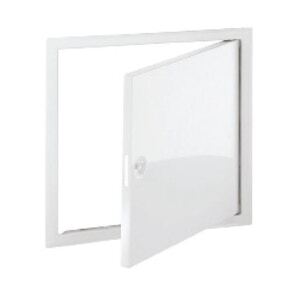In construction projects, it can be difficult to know which hatches are best suited for different purposes.
- With over 50 different types of hatches in our standard stock, Helnor probably has the largest selection on the market.
- To make it easier for you to find the hatch that best suits your needs, we have made a to-do list of what you should think about.
The hatch assistant for wall hatches provides good tips for choosing the right hatch. The hatch assistant for wall hatches can be found on our website.
Wall hatches that suit your needs!
- We supply wall hatches in various sizes for building and construction.
- The wall hatches are produced in MDF, aluminum, steel, and stainless steel.
- Our wall hatches have various properties such as fire classification, odor, dust and water tightness, as well as noise reduction (32-54 dB).
We have a large selection of wall hatches with different functions. See a full overview here.

Where should the hatch be placed?
In order to find out which hatch is best suited for your purpose, both the area of use and the location of the hatch must be clarified.
A wall hatch is designed to be tight in a vertical position, but not made to withstand heavy loads.
A sunroof that is to be mounted outside and protrude above the roof, must be designed to be waterproof and windproof.
A ceiling hatch provides access to a technical installation in the ceiling, and often there is a desire for the hatch to blend in with the surroundings.
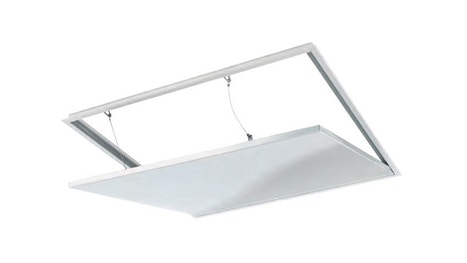
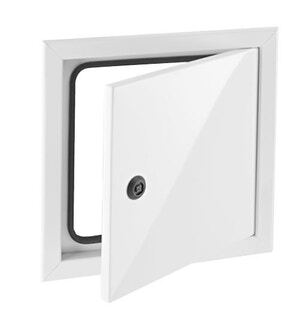
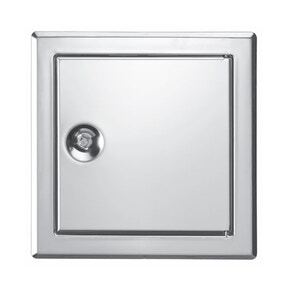
What fire requirements do I have to deal with?
Fire classification is a system for classification of fire technical properties, based on standardized test methods and criteria. There are various classification systems related to buildings, structures, products, and extinguishing agents.
A product that will provide resistance for one hour has the designation EI 60, and it is short for:
- “E” is short for integrity (density).
- “I” is short for insulation.
- “60” is short for minutes, i.e. resistance in number of minutes
We have approved hatches in different fire classifications that you can read more about here.
What are the current fire requirements for different types of buildings and installations?
An overview of requirements and solutions for fire engineering design of buildings can be found in Byggforsk documents here (Norwegian)!
An overview of current fire requirements is the responsibility of the Fire Consulting Engineer, so-called FCE. That is, design and calculation of fire safety. FCE will be able to tell you what kind of classification the current wall and hatch have in the building’s fire concept. It is important that the fire concept is followed and that projected fire cells are not broken with the use of incorrectly classified hatches.
We have hatches with fire requirements from EI30 and up to EI120. The EI standard is available in two editions, EI1 and EI2. Our hatches satisfy both varieties.
Fire hatches often also have requirements for smoke and gas tightness. We deliver hatches according to SA classification. Requirements for CSA classification involve self-closing hatches. Due to requirements for closing mechanisms, we would recommend the use of doors for such fire barriers.

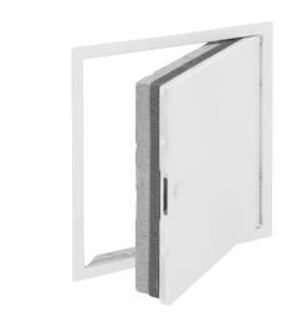
Where do I find the density of hatches?
- Requirements for smoke and gas tightness occur on fire hatches, so-called SA classification. Hatches that are waterproof, odorproof, dustproof, and sound-reducing can show for testing.
- The class designation S is used to indicate smoke leakage for building components. S is used to describe that, for example, a door, gate, or hatch is self-closing.
What functions can the hatch have?
When should the hatch have hinges?
It is especially important to have a hinged hatch in the ceiling.
This makes the ceiling hatch easier to handle, and leads to less risk of personal injury.
The hatches in the ceiling should always be hinged.
Hinges also improve the user-friendliness of the wall hatches.
The frequency of opening/closing can be a factor when choosing a wall hatch with or without hinges.
Which hatches are lockable?
For security reasons, it can sometimes be important and appropriate to be able to lock the hatch.
For hatches in walls and ceilings, key locks and square locks are common, and something that is widely used on several different types of inspection hatches. The fire doors in our selection all have locking options.

